Advanced Beekeeping
 Print This Post
Print This Post
By Justin Duncan, Sustainable Agriculture Specialist
Sometimes, in the course of events, having knowledge leads folks in odd directions. One of those directions could even be driving down the highway with a chunk of tree full of bees.
A fellow needed help with said bees. He’d knocked them and their tree over with his tractor while mowing. He knew the tree to be dead and took the opportunity to start preparing it for burning. It didn’t go so well for him. We are in the period known as the summer dearth when there aren’t many flowers available for the bees. Strike 1. The bees were upset more than normal when their home was knocked over, and they unleashed a stinging frenzy upon the hapless landowner. The area these bees were, in addition to being in the heart of the dearth, was mostly cedar and other non-nectar producing plants. Strike 2. By the time I was alerted to the situation, it had been over a week and the bees’ opportunistic, relentless, marauding cousins, the ants, had robbed the bees of their honey stores. Strike 3. This hive was on its last legs by the time I arrived. Once I got there, the bees were HOT, sting-y, starving and hangry. Don’t mess with hangry bees.
In this case, I had no choice and the landowner wanted them gone so I used my FLIR to locate the center of the hive. This can be a bit more difficult to do in logs than in walls because of the thicker insulation of the wood but, luckily, I was able to find the heat mass. This let me know where to start cutting with the chainsaw. It’s an important step because just guessing and cutting toward the center of the heat mass is going to cause a lot of damage to the hive and prove to the already hot, sting-y, and hangry bees beyond the shadow of a doubt that you are ENEMY. Cutting out by the periphery of the hive maybe gives them the benefit of the doubt.

Misaligned comb, unusable by the bees except for recycle materials. It’s empty due to exposure to ants. Photo: Justin Duncan, NCAT
To add insult to injury, the hive fell in such a way that the comb was oriented in an unusable tangent. The queen couldn’t use them to lay new eggs and the workers couldn’t use them to store honey. Almost all the available space in the log hollow was filled with comb and, judging by the color of the wax, it was an old hive. This didn’t give them much wiggle room to continue as a viable hive. Another strike.
I cut a foot or so to either side of the hot spot and threw the log on the back of the truck. I recovered as much of the wood as possible that had comb or bees in it, covered it up, tied it all down, and scooted on home.
Getting the hangry bees is the first phase in a pretty lengthy process. Tree bees have a nasty habit of absconding, at least for me. I didn’t want that…even though these bees were the hottest bees I have dealt with in a long time, they still are honeybees and thus have the potential to be benefit to me. I needed these to stick around and for that I need them to feel confident in their home, however different it was from before. My ever-present enemies, Paratrechina longicornis, the crazy ants, are a frustrating reality for me. On one hand, I couldn’t try to put these bees in a hive body lest they abscond. Nor could I just leave them any old place for the ants to destroy. I decided to hang ‘em high. Doing this in a full bee suit in the heat is not a fun task.
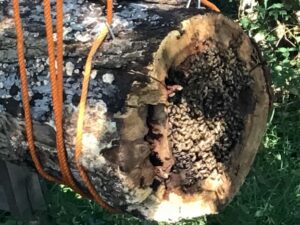
Close-up of the suspended bee log. Photo: Justin Duncan
In the interest of causing as little additional disruption as possible, I piled up some pallets awaiting disassembly and then painstakingly placed the bee log on the stack, ensuring the proper alignment of the comb. Using some largish fence staples, I secured a length of rope to the bee log and started suspending it from a couple branches of my tree. I couldn’t imagine doing this task with a healthy hive full of brood and honey, as it was difficult enough with a dry, unhealthy, unhappy hive. Once it was tentatively suspended, I wrapped as much rope around the log as possible and secured the ropes with hose clamps.
Once the bees were suspended, I needed to figure out how to get them reorganized into frame bees and give up their old lives as log bees. To this end, I added outriggers to the bee log. The outriggers serve as a framework that allowed me to add frames. The frames, once attached and lined up, serve as a base for the feeder bottle.
Remember that old comb I salvaged from the other side of the bee log? Well, I attached that to some frames I had laying around. This gives the bees a bit of a head start, since they had no more room to build inside the log.
Once the frames were solidly in place, I put a hive body on top of them. I didn’t put frames in the hive body. I’m just using it as a shelter for the feeder bottles. Once the bees were fed with sugar syrup they calmed down from fully aggravated, I’m-going-to-sting-you-to put-myself-out-of-my-miserable-starving-existence bees to semi-civilized, I’m–going–to–fly-in-your-face-threateningly bees.
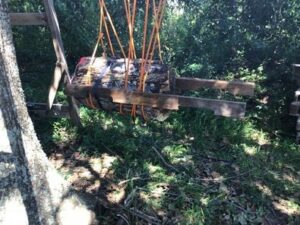
Outriggers attached to the bee log. Photo: Justin Duncan, NCAT
Be sure that if you attempt this, you are appropriately geared in your personal protective equipment of choice. I was stung more times during this operation than I have been in a very long time. These bees were very disrespectful, stinging me in my face whenever the opportunity presented itself. They are all calmed down now and even starting to explore the frames I set up for them. It’s amazing what copious amounts of sugar water syrup will do to improve the temperament of an unhappy bee.
A note on feeder bottles: There are several styles, but I prefer the one I can make myself out of a couple pieces of wood and attach an inverted Mason jar with a perforated lid.
“Rescuing” bees is an art and a science, like much of agriculture. Leave it to beekeepers because it’s not one of those things that should be done after reading a book or watching a few videos online. One has to know how to react, what to do in certain circumstances, how to remain cool under pressure, and be able to take a sting or even a dozen stings. These things come with experience, practice, and patience. In other words, don’t try this at home if you haven’t been taught by a beekeeper.
Related ATTRA Resources:
Alternative Pollinators: Native Bees
Beekeeping: Considerations for the Ecological Beekeeper
This blog is produced by the National Center for Appropriate Technology through the ATTRA Sustainable Agriculture program, under a cooperative agreement with USDA Rural Development. ATTRA.NCAT.ORG.

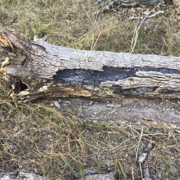
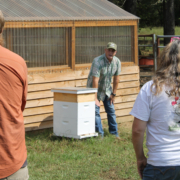
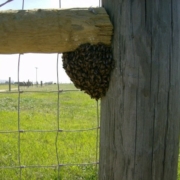
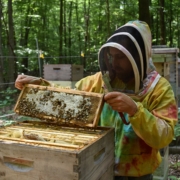

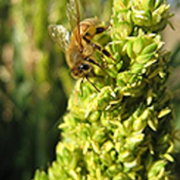
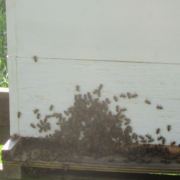
 USDA photo by Lance Cheung
USDA photo by Lance Cheung


